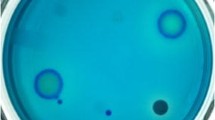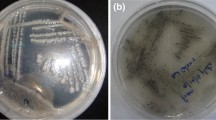Abstract
One marine bacteria Bacillus pumilus was isolated using allura red as ε-poly-L-lysine (ε-PL) secretion indicator. But actually the product was identified as poly-γ-L-diaminobutanoic acid (γ-PAB) by ionization-time-of-flight mass spectrometry, not coproduced with ε-PL. The polymerization degree of γ-PAB was 4–22, namely short-chain γ-PAB, compared with that in S. celluloflavus, and it exhibited stronger inhibitory activities against yeasts than long-chain γ-PAB but weaker activities against bacteria. The fermentative behavior of B. pumilus was investigated, and the γ-PAB production was 38.6 mg/L in shake flask and was enhanced to 284.2 mg/L in 5-L bioreactor by a pH control strategy. Interestingly, the suitable pH for B. pumilus to produce γ-PAB was 4.8, different from 4.0 for current Streptomyces strains, which suggests a potential new metabolic mechanism in B. pumilus as a novel γ-PAB producer. No studies on short-chain γ-PAB production in bacteria have been reported previously and we considered that this is a new discovery in the field of homopolymer research.





Similar content being viewed by others
Data Availability
All data generated or analysed during this study are included in this published article.
References
Kunioka M (1997) Biosynthesis and chemical reactions of poly(amino acid)s from microorganisms. Appl Microbiol Biotechnol 47:469–475. https://doi.org/10.1007/s002530050958
Yamanaka K, Maruyama C, Takagi H (2008) epsilon-poly-l-lysine dispersity is controlled by a highly unusual nonribosomal peptide synthetase. Nat Chem Biol 4:766–772. https://doi.org/10.1038/nchembio.125
Obst M, Steinbüchel A (2004) Microbial degradation of poly(amino acid)s. Biomacromol 5:1166–1176. https://doi.org/10.1021/bm049949u
Hiraki J, Ichikawa T, Ninomiya S (2003) Use of ADME studies to confirm the safety of polylysine as a preservative in food. Regul Toxicol Pharm 37:328–340. https://doi.org/10.1016/S0273-2300(03)00029-1
Xia J, Xu H, Feng X, Xu Z, Chi B (2013) Poly(L-diaminopropionic acid), a novel non-proteinic amino acid oligomer co-produced with poly(ε-l-lysine) by Streptomyces albulus PD-1. Appl Microbiol Biot 97:7597–7605. https://doi.org/10.1007/s00253-013-4936-4
Takehara M, Saimura M, Inaba H, Hirohara H (2008) Poly(γ-L-diaminobutanoic acid), a novel poly(amino acid), coproduced with poly(ε-L-lysine) by two strains of Streptomyces celluloflavus. FEMS Microbiol Lett 286:110–117. https://doi.org/10.1111/j.1574-6968.2008.01261.x
Xu Z-X, Sun Z-Z, Li S, Xu Z, Cao C-G, Xu Z-Q, Feng X-H, Xu H (2015) Systematic unravelling of the biosynthesis of poly(L-diaminopropionic acid) in Streptomyces albulus PD-1. Sci Rep 5:17–28. https://doi.org/10.1038/srep17400
Chen X-S, Ren X-D, Zeng X, Mao Z-G (2013) Enhancement of ε-poly-L-lysine production coupled with precursor L-lysine feeding in glucose-glycerol co-fermentation by Streptomyces sp. M-Z18. Bioprocess Biosyst Eng 36:1843–1849. https://doi.org/10.1007/s00449-013-0958-7
Hirohara H, Munenori T, Masayuki S (2006) Biosynthesis of poly(ε-L-lysine)s in two newly isolated strains of Streptomyces sp. Appl Microbiol Biotechnol 73:321–331. https://doi.org/10.1007/s00253-006-0479-2
Zhang Y, Feng X-H, Xu H, Yao Z (2010) ε-Poly-L-lysine production by immobilized cells of Kitasatospora sp. MY 5–36 in repeated fed-batch cultures. Bioresour Technol 14:5523–5527. https://doi.org/10.1016/j.biortech.2010.02.021
Li S, Tang L, Chen X-S, Liao L-J, Li F, Mao Z-G (2011) Isolation and characterization of a novel ε-poly-L-lysine producing strain: Streptomyces griseofuscus. J Ind Microbiol Biotechnol 38:557–563. https://doi.org/10.1007/s10295-010-0803-9
Li S, Li F, Chen X-S, Wang L, Tang L, Mao Z-G (2012) Genome shuffling enhanced ε-Poly-L-Lysine production by improving glucose tolerance of Streptomyces graminearus. Appl Biochem Biotechnol 166:414–423. https://doi.org/10.1007/s12010-011-9437-2
Nermeen A, Abeer E, Samia S, Dunja M, Soraya A (2012) Antibacterial and anticancer activity of ε-poly-L-lysine (ε-PL) produced by a marine Bacillus subtilis sp. J Basic Microb 52:1–10. https://doi.org/10.1002/jobm.201100290
Anuj HC, Madhavi R (2015) Enhancement of ε-poly-L-lysine (ε-PL) production by a novel producer Bacillus cereus using metabolic precursors and glucose feeding. Biotech 5:839–846. https://doi.org/10.1007/s13205-015-0291-8
Wang L, Chen X-S, Wu G-Y, Zeng X, Ren X-D, Li S, Mao Z-G (2016) Genome shuffling and gentamicin-resistance to improve ε-poly-L-lysine productivity of Streptomyces albulus W-156. Appl Biochem Biotechnol 180:1601–1617. https://doi.org/10.1007/s12010-016-2190-9
Nishikawa M, Ogawa K (2002) Distribution of microbes producing antimicrobial ε-Poly-L-Lysine polymers in soil microflora determined by a novel method. Appl Environ Microb 68:3575–3581. https://doi.org/10.1128/AEM.68.7.3575-3581
Shima S, Sakai H (1981) Poly-L-lysine produced by Streptomyces. part III. chemical studies. Agric Biol Chem 45:2497–2502. https://doi.org/10.1080/00021369.1981.10864930
Takehara M, Hibino A, Saimura M, Hirohara H (2010) High-yield production of short chain length poly(ε-L-lysine) consisting of 5–20 residues by Streptomyces aureofaciens, and its antimicrobial activity. Biotechnol Lett 32:1299–1303. https://doi.org/10.1007/s10529-010-0294-9
Kahar P, Lwata T, Hiraki J (2001) Enhancement of ε-poly-L-lysine production by Streptomyces albulus strain 410 using pH control. J Biosci Bioeng 91:190–194. https://doi.org/10.1016/S1389-1723(01)80064-5
Kito M, Takimoto R, Yoshida T, Nagasawa T (2002) Purification and characterization of ε-poly-L-lysine-degrading enzyme from the ε-poly-L-lysine tolerant Chryseobactrium sp QJ7. J Biosci Bioeng 1:92–104. https://doi.org/10.1016/S1389-1723(03)90105-8
Yamanaka K, Kito N, Imokawa Y (2010) Mechanism of ε-poly-L-lysine production and accumulation revealed by identification and analysis of an ε-poly-L-lysine degrading enzyme. Appl Environ Microbiol 68:5669–5675. https://doi.org/10.1128/AEM.00853-10
Acknowledgement
We appreciated Liang Wang for mass spectrometry analysis in the manuscript.
Funding
This work was financially supported by Shandong Natural Science Foundation (ZR2019BC044).
Author information
Authors and Affiliations
Corresponding author
Ethics declarations
Competing interest
The authors declare that they have no competing interests.
Ethical Standards
All analyses were based on previous published studies, thus no ethical approval and patient consent are required.
Ethics Approval
This article does not contain any studies with human participants or animals performed by any of the authors.
Additional information
Publisher's Note
Springer Nature remains neutral with regard to jurisdictional claims in published maps and institutional affiliations.
Rights and permissions
About this article
Cite this article
Li, S., Yao, Y., Hu, S. et al. Short-Chain Poly(γ-diaminobutanoic acid), A Poly(amino acid) Produced by a Marine Bacteria Bacillus pumilus. Curr Microbiol 78, 1142–1149 (2021). https://doi.org/10.1007/s00284-021-02371-6
Received:
Accepted:
Published:
Issue Date:
DOI: https://doi.org/10.1007/s00284-021-02371-6




